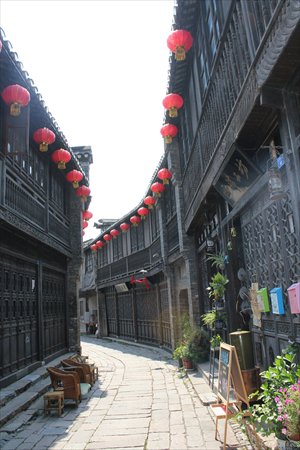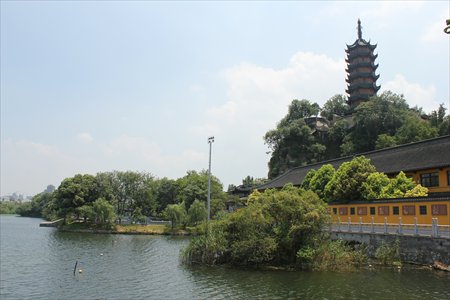Fairy tale visit to Zhenjiang


Located between busy Shanghai and bustling Nanjing, Zhenjiang is a quiet town that can be easily overlooked, like a pretty girl of humble birth. This ancient city in the south of Jiangsu Province is small, but it boasts a breathtaking landscape. Lying along the Yangtze River, the city is flanked by Taihu Lake to the east and the Qinhuai River to the west, and it is surrounded by mountains.
Zhenjiang, which was listed as a national historical and cultural city in 1986, is said to be the birthplace of the ancient Wu culture, which covered the eastern coastal region of China and rose to prominence during the Spring and Autumn Period (770-476 BC).
After a four-hour high-speed train ride from Beijing, I set foot in this city and immediately forgot the frenzy of the capital. Shrouded in tranquility, Zhenjiang is a great destination for those who crave an escape from big cities like Beijing, Shanghai and Guangzhou. In addition to the stunning natural beauty and historical sites that hypnotized me into thinking I would never leave, I was also impressed by the amiability of the locals: I fell asleep on a bus, and the driver kindly woke me up when we had reached my stop.
Stories and temples
Jinshan Park is the best place for tourists to begin soaking up Zhenjiang. Three kilometers from the downtown area, this park boasts a cluster of historical sites that are said to be the settings of some of China's most fascinating legends and fairy tales. Four famous lovers' legends, including that of the Cowherd and the Weaving Maid (the inspiration for Qixi Festival, also known as Chinese Valentine's Day), all took place here.
A central attraction of this park is Jiangtianchan Temple, a Buddhist temple formerly known as Jinshan Temple, for which the park was named. Built during the Eastern Jin Dynasty (317-420), this ancient temple was one of the four best-known temples in China during the Qing Dynasty (1644-1911). Emperor Kangxi of the Qing renamed the temple, and the script above its gate today was in fact written by this royal family member.
The temple's architectural style cleverly blends with its mountainous surroundings. Rows upon rows of halls, pavilions and castles cling tightly to the mountain, making for a dazzling feast for the eyes. Throughout the centuries, Chinese writers have found inspiration in this site, many dedicating poems to the temple.
I climbed up the hill to Cishou Pagoda, where I discovered a bird's eye view of Jinshan Park and beyond, following the Yangtze River. While the scenery made me long for a ride in a boat, I knew I had to investigate some of the sites that claim to be part of China's greatest legends.
Jinshan Hill is a mountain of fairy tales, with stories abounding on every site. One of my favorites is about Fahai and Bai Suzhen. It is said that, during the Tang Dynasty (618-907), Fahai discovered gold along the Yangtze River and presented it to the emperor, who ordered that it be used to restore the temple, naming Fahai the abbot. But most people know another story that paints him in a less favorable light, a legend that is perhaps the main reason that Jinshan Temple is so famous today.
Bai, a powerful snake spirit who morphed into a woman, married a man named Xu Xian as reciprocation since he saved her life over 1,000 years ago. Fahai was bitter about their union and imprisoned Xu inside the temple. In a rage, Bai flooded the temple with the help of another sorceress, Xiaoqing, and Xu was able to escape during the chaos.
Today, sculptures of Bai and Xiaoqing stand outside Bai's former home, the White Serpent Den, to the north of Fahai Cave. According to legend, an unfathomable passageway at the back of the den leads directly to the Broken Bridge in Hangzhou, where Bai and Xu first met and fell in love. Such legends added magic to my visit.
After exploring these otherworldly sites, tourists can have lunch in the park. There is a restaurant facing Jinshan Temple that serves vegetarian food, but don't arrive there too late, because they close their doors in the early afternoon.
Xijin Ferry Dock
Before I had finished reflecting on the famous tales of Jinshan Park, I had arrived at the Xijin Ferry Dock. Only a 10-minute drive from the park, this dock lies at the foot of Yuntai Mountain and has been vital to transportation on the Yangtze River since at least the Three Kingdoms Period (220-280).
Tucked in between the mountains and the Yangtze River, the ferry dock has long been a favorite spot for poets and visitors alike to enjoy breathtaking scenery. Ancient poets from the Tang Dynasty, like Li Bai and Meng Haoran, as well as the Song Dynasty (960-1279), like Su Shi, are said to have found inspiration here.
Just next to the ancient waterfront, rows of restored buildings imitating the original style of the Qing Dynasty compose a charming street of bars and shops selling Zhenjiang specialties, such as the famous Hengshun brand vinegar, guogai mian (noodles with shrimp meat), and various handicrafts.
As I sat inside the nearby waiting pavilion and looked down at the complex architecture and quiet streets below, I imagined how people in ancient times carried their luggage and rushed for the boats like we rush for trains and planes today.
Just west of the pavilion is an ancient wharf street paved with blue stones that date back to the Tang Dynasty. It is said that there used to be over 150 shops on the roughly 500-meter-long street, selling everything from food to services for boatmen. The deep grooves made by wheels in the stone road long ago tell modern visitors what a bustling place this port was in older times.
Han Suyin, a Chinese-born British writer, once pinpointed the feeling of this storied lane: "Walking on this ancient street is like strolling through a natural history museum."
Dreaming on Jiaoshan Hill
After a day of sightseeing, I took to the secluded Jiaoshan Hill to unwind. This hill is in fact an island in the Yangtze River, and it looks like a piece of floating jade from afar.
Unlike Jinshan Hill, the temple and pavilions on Jiaoshan Hill are hidden amid the landscape and trees. Away from the noise of downtown Zhenjiang, the hill is tranquil and romantic, particularly during sunset, when lovers flock here. The ferry that takes visitors to the secluded island is an extraordinary experience on its own, offering a lovely view of Jiaoshan Hill and the beautiful scenery along the Yangtze River.
Dinghui Temple, on the southern slope of the island, is the first thing you see when you get off the boat. Built during the Eastern Han Dynasty (25-220), this temple is over 1,700 years old. While its architecture is mostly reminiscent of the Ming Dynasty (1368-1644), the occasionally strolling monks who stop to take pictures will remind you that you are living in the modern world.
In addition to Dinghui Temple, there are over 10 other Buddhist temples and nunneries on the island. There used to be famous monks from each temple, talented in music, calligraphy or painting, giving rise to Jiaoshan Hill's other name, "Culture Hill."
This river island is filled with important cultural sites, the most famous of which is Jiaoshan Stele Forest. As the biggest of its kind along the southern part of the Yangtze River, the forest boasts about 500 inscriptions of calligraphy works, second only to Xi'an's steles.
One of the most famous relics in this area is the Yihe Ming Rock Inscription, which was first discovered during the Song Dynasty. This relic is considered the forefather of fine Chinese calligraphy, due to its rare artistic characteristics and its integration of different calligraphy styles, which was unique at the time.
On the west side of Jiaoshan Hill, facing the river, are steep cliffs that display the inscriptions of countless poets and calligraphers spanning thousands of years. The styles that can be seen cover clerical script, cursive script, seal script and so on, forming a natural exhibition of ancient calligraphy. This site is the favorite attraction of many calligraphy lovers and historians.
I lingered on Jiaoshan Hill and forgot the time until the staff kindly reminded me that I needed to catch the last boat off the island to get back to the city. If I had brought a tent, I would have loved to stay all night, enjoying the beauty of these tranquil surroundings.
On my way back, I was sad to be leaving so soon. Exiting Zhenjiang felt as if I was awakening from a beautiful, enchanting dream. I found solace in the knowledge that these magical places would be there, waiting for me to explore them further. I knew I would return to Zhenjiang.
Rules of thumb
1. Getting there: Located between Nanjing and Shanghai, Zhenjiang is pretty easy to get to from most parts of China. In addition to standard rail, the Beijing-Shanghai high-speed railway is the most convenient route for tourists living along that line, getting you to Zhenjiang within four hours. But be prepared to run into difficulties getting tickets for the National Day holiday. If you want to avoid the anxiety of booking train tickets, you can drive to Zhenjiang or take a long-distance bus. You can even fly into Nanjing or Shanghai first.
2. When to go: Spring and autumn are the best seasons to visit Zhenjiang. The upcoming holiday is the best time of year in this city, with fine weather, sufficient sunshine and relatively low humidity. It's recommended that you book a hotel before the tourism peak hits.
3. What to taste: Try Zhenjiang's three "queer" specialties: crystal pork, guogai mian, and vinegar; and be sure to eat local fish from the Yangtze River.
4. Picking up souvenirs: Good places to buy gifts for friends and family are Zhongshan East Road, the night market on South Gate Street, and the areas around the Xijin Ferry Dock.